Deck 15: Extension: Advanced Methods for Project Scheduling
Question
Question
Question
Question
Question
Question
Question
Question
Question
Question
Question
Question
Question
Question
Question
Question
Question
Question
Question
Question
Question
Question

Unlock Deck
Sign up to unlock the cards in this deck!
Unlock Deck
Unlock Deck
1/22
Play
Full screen (f)
Deck 15: Extension: Advanced Methods for Project Scheduling
1
Given the tasks, estimated durations, and crash costs shown below, if the benefit to crash the project by each day is a maximum of $750, how many days would it be worthwhile to crash the project? 
A)0
B)1
C)2
D)3
E)4

A)0
B)1
C)2
D)3
E)4
1
2
The customer has offered a $10,000 bonus if the project is completed within 14 days. What is the probability that the bonus will be earned?
A)Approximately 85 percent
B)Approximately 5 percent
C)Approximately 2.3 percent
D)Approximately 97.7 percent
A)Approximately 85 percent
B)Approximately 5 percent
C)Approximately 2.3 percent
D)Approximately 97.7 percent
Approximately 2.3 percent
3
A simple sequential project (each task must be completed before the next one can begin) has the time estimates (in days) shown below: 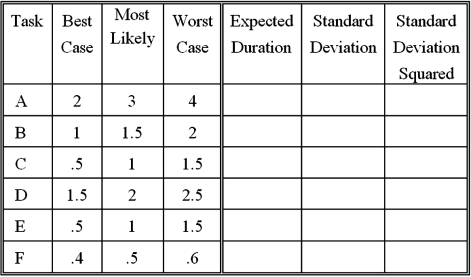 What is the likelihood the project will be completed in 10 days?
What is the likelihood the project will be completed in 10 days?
A)Between 88 and 88 percent
B)Between 89 and 92 percent
C)Between 93 and 98 percent
D)Between 99 and 100 percent
 What is the likelihood the project will be completed in 10 days?
What is the likelihood the project will be completed in 10 days?A)Between 88 and 88 percent
B)Between 89 and 92 percent
C)Between 93 and 98 percent
D)Between 99 and 100 percent
Between 93 and 98 percent
4
Annie is planning a large surprise party for her sister Gwendolyn. She has developed the following plan, including estimates of the time (in hours) and cost necessary to perform each of the tasks required.  What is the planned duration of the preparation for the surprise party, assuming the critical path is completed?
What is the planned duration of the preparation for the surprise party, assuming the critical path is completed?
A)16 hours
B)8 hours
C)20 hours
D)30 hours
 What is the planned duration of the preparation for the surprise party, assuming the critical path is completed?
What is the planned duration of the preparation for the surprise party, assuming the critical path is completed?A)16 hours
B)8 hours
C)20 hours
D)30 hours

Unlock Deck
Unlock for access to all 22 flashcards in this deck.
Unlock Deck
k this deck
5
A project manager has discovered that three tasks are on the critical path for a particular project. She has developed the time estimates (in days) shown in the table below. Complete the table and determine the expected completion time for the project. 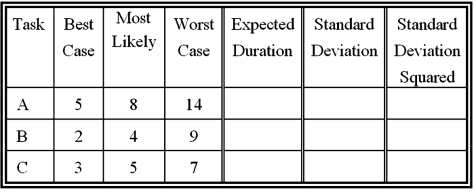
A)17 days
B)18 days
C)21 days
D)19 days

A)17 days
B)18 days
C)21 days
D)19 days

Unlock Deck
Unlock for access to all 22 flashcards in this deck.
Unlock Deck
k this deck
6
Given the project data below, what is the expected length of path A, B, C? 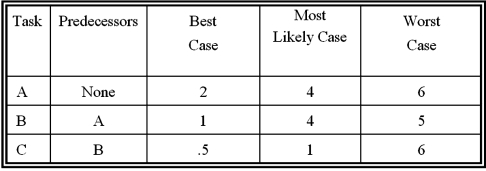
A)9.0
B)9.8
C)9.4
D)17

A)9.0
B)9.8
C)9.4
D)17

Unlock Deck
Unlock for access to all 22 flashcards in this deck.
Unlock Deck
k this deck
7
In evaluating time-cost trade-offs, we start by crashing the task on the critical path that:
A)Has the lowest cost to reduce by one unit of time.
B)Has the lowest total crash cost.
C)Can be reduced the most.
D)Is the longest.
E)None of the these.
A)Has the lowest cost to reduce by one unit of time.
B)Has the lowest total crash cost.
C)Can be reduced the most.
D)Is the longest.
E)None of the these.

Unlock Deck
Unlock for access to all 22 flashcards in this deck.
Unlock Deck
k this deck
8
Annie is planning a large surprise party for her sister Gwendolyn. She has developed the following plan, including estimates of the time (in hours) and cost necessary to perform each of the tasks required.  What is Annie's total benefit from crashing this project?
What is Annie's total benefit from crashing this project?
A)$55
B)$185
C)$160
D)$240
 What is Annie's total benefit from crashing this project?
What is Annie's total benefit from crashing this project?A)$55
B)$185
C)$160
D)$240

Unlock Deck
Unlock for access to all 22 flashcards in this deck.
Unlock Deck
k this deck
9
Given the tasks, estimated durations, and crash costs shown below, what is the total cost of the steps needed to provide the cheapest way to reduce the project length by three days? 
A)$2,800
B)$2,500
C)$1,100
D)$2,300

A)$2,800
B)$2,500
C)$1,100
D)$2,300

Unlock Deck
Unlock for access to all 22 flashcards in this deck.
Unlock Deck
k this deck
10
Task X has a best-case duration of 4 days, a worst-case duration of 10 days, and a most likely duration of 6 days. Using this information, we can estimate a 50 percent probability that the task will be completed in no more than how many days?
A)6.0 days
B)3.3 days
C)10.0 days
D)6.3 days
A)6.0 days
B)3.3 days
C)10.0 days
D)6.3 days

Unlock Deck
Unlock for access to all 22 flashcards in this deck.
Unlock Deck
k this deck
11
A simple sequential project (each task must be completed before the next one can begin) has the time estimates (in days) shown below: 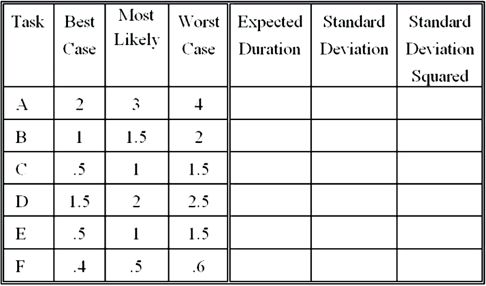 What is the probability that the project shown in Exhibit 15S-5 will be completed within 8.5 days? (Choose the closest answer.)
What is the probability that the project shown in Exhibit 15S-5 will be completed within 8.5 days? (Choose the closest answer.)
A)80 percent
B)20 percent
C)75 percent
D)5 percent
 What is the probability that the project shown in Exhibit 15S-5 will be completed within 8.5 days? (Choose the closest answer.)
What is the probability that the project shown in Exhibit 15S-5 will be completed within 8.5 days? (Choose the closest answer.)A)80 percent
B)20 percent
C)75 percent
D)5 percent

Unlock Deck
Unlock for access to all 22 flashcards in this deck.
Unlock Deck
k this deck
12
Annie is planning a large surprise party for her sister Gwendolyn. She has developed the following plan, including estimates of the time (in hours) and cost necessary to perform each of the tasks required.  Annie will save $40 for every hour she can reduce from her plan. Annie has decided to crash her project and use the money she saves to purchase a larger gift for Gwendolyn. Which task should she crash first?
Annie will save $40 for every hour she can reduce from her plan. Annie has decided to crash her project and use the money she saves to purchase a larger gift for Gwendolyn. Which task should she crash first?
A)A
B)D
C)C
D)E
E)B
 Annie will save $40 for every hour she can reduce from her plan. Annie has decided to crash her project and use the money she saves to purchase a larger gift for Gwendolyn. Which task should she crash first?
Annie will save $40 for every hour she can reduce from her plan. Annie has decided to crash her project and use the money she saves to purchase a larger gift for Gwendolyn. Which task should she crash first?A)A
B)D
C)C
D)E
E)B

Unlock Deck
Unlock for access to all 22 flashcards in this deck.
Unlock Deck
k this deck
13
Annie is planning a large surprise party for her sister Gwendolyn. She has developed the following plan, including estimates of the time (in hours) and cost necessary to perform each of the tasks required.  If Annie crashes only the task identified in the previous problem, but crashes it to its minimum duration, how much will she save on the project?
If Annie crashes only the task identified in the previous problem, but crashes it to its minimum duration, how much will she save on the project?
A)$55
B)$185
C)$160
D)$50
 If Annie crashes only the task identified in the previous problem, but crashes it to its minimum duration, how much will she save on the project?
If Annie crashes only the task identified in the previous problem, but crashes it to its minimum duration, how much will she save on the project?A)$55
B)$185
C)$160
D)$50

Unlock Deck
Unlock for access to all 22 flashcards in this deck.
Unlock Deck
k this deck
14
Annie is planning a large surprise party for her sister Gwendolyn. She has developed the following plan, including estimates of the time (in hours) and cost necessary to perform each of the tasks required.  Annie turns her attention to crashing another task in her project. If she wants to benefit even more, what is the next task to crash?
Annie turns her attention to crashing another task in her project. If she wants to benefit even more, what is the next task to crash?
A)A
B)C
C)E
D)F
 Annie turns her attention to crashing another task in her project. If she wants to benefit even more, what is the next task to crash?
Annie turns her attention to crashing another task in her project. If she wants to benefit even more, what is the next task to crash?A)A
B)C
C)E
D)F

Unlock Deck
Unlock for access to all 22 flashcards in this deck.
Unlock Deck
k this deck
15
An estimate of the duration of a task that is based on a weighted average of a range of possible task durations is known as:
A)Most likely duration.
B)Expected duration.
C)Worst-case duration.
D)Probabilistic duration.
A)Most likely duration.
B)Expected duration.
C)Worst-case duration.
D)Probabilistic duration.

Unlock Deck
Unlock for access to all 22 flashcards in this deck.
Unlock Deck
k this deck
16
A simple sequential project (each task must be completed before the next one can begin) has the time estimates (in days) shown below:  What is the expected total time for the path?
What is the expected total time for the path?
A)7.33 days
B)9.00 days
C)10 days
D)12.67 days
 What is the expected total time for the path?
What is the expected total time for the path?A)7.33 days
B)9.00 days
C)10 days
D)12.67 days

Unlock Deck
Unlock for access to all 22 flashcards in this deck.
Unlock Deck
k this deck
17
Given the project data below, what is the standard deviation of durations for path A, B, C?" 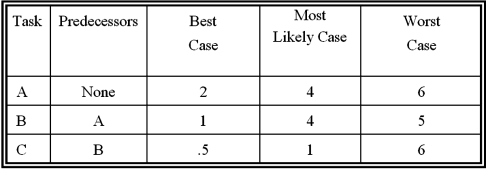
A)1.4
B)2.3
C)1.7
D)None of the choices is correct

A)1.4
B)2.3
C)1.7
D)None of the choices is correct

Unlock Deck
Unlock for access to all 22 flashcards in this deck.
Unlock Deck
k this deck
18
Which of the following statements best describes "crash cost"?
A)Estimated cost to reduce a project task duration by one time unit.
B)Estimated cost to reduce a project duration by one time unit.
C)Estimated cost to reduce the project schedule by one time unit.
D)Actual cost to reduce a project duration by one time unit.
E)Actual cost to change a project schedule.
A)Estimated cost to reduce a project task duration by one time unit.
B)Estimated cost to reduce a project duration by one time unit.
C)Estimated cost to reduce the project schedule by one time unit.
D)Actual cost to reduce a project duration by one time unit.
E)Actual cost to change a project schedule.

Unlock Deck
Unlock for access to all 22 flashcards in this deck.
Unlock Deck
k this deck
19
Which of the following statements is true regarding crash costs?
A)Crash costs tend to increase with each additional day of crashing.
B)Crash costs tend to decrease with each additional day of crashing.
C)It is usually cheaper to crash tasks that are not on the critical path.
D)Additional crash costs are rarely justified in practice.
A)Crash costs tend to increase with each additional day of crashing.
B)Crash costs tend to decrease with each additional day of crashing.
C)It is usually cheaper to crash tasks that are not on the critical path.
D)Additional crash costs are rarely justified in practice.

Unlock Deck
Unlock for access to all 22 flashcards in this deck.
Unlock Deck
k this deck
20
A project manager has discovered that three tasks are on the critical path for a particular project. She has developed the time estimates (in days) shown in the table below. Complete the table and determine the expected completion time for the project. 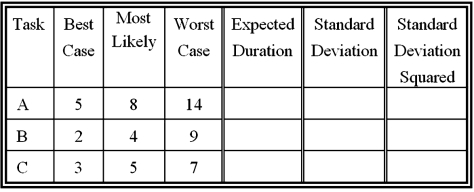
A)Approximately 92 percent
B)Approximately 88 percent
C)Approximately 75 percent
D)Approximately 84 percent

A)Approximately 92 percent
B)Approximately 88 percent
C)Approximately 75 percent
D)Approximately 84 percent

Unlock Deck
Unlock for access to all 22 flashcards in this deck.
Unlock Deck
k this deck
21
If a project path has an expected duration of 10 days and a standard deviation of 3 days, what is the probability that the path will be completed in 13 days or less?
A)50 percent
B)33 percent
C)75 percent
D)84 percent
A)50 percent
B)33 percent
C)75 percent
D)84 percent

Unlock Deck
Unlock for access to all 22 flashcards in this deck.
Unlock Deck
k this deck
22
If a project path has an expected duration of 10 days and a standard deviation of 3 days, what is the probability that the path will be completed in 10 days or less?
A)0 percent
B)33 percent
C)50 percent
D)75 percent
A)0 percent
B)33 percent
C)50 percent
D)75 percent

Unlock Deck
Unlock for access to all 22 flashcards in this deck.
Unlock Deck
k this deck



